This morning I looked outside my large living room window and was greeted by snow. It had started snowing early morning, and the weather had decided it was a good idea to continue throughout the morning. Granted it wasn’t much snow, but it was enough to squelch my plans for getting my planter boxes up and ready for summer. I wanted to cry. Or at the very least feel sorry for myself and frustrated with the prospect of having to find indoor projects when my heart yearned to be outdoors, planting and working in the yard.
Resigning myself to the fact I would be working indoors most of the day (I had plenty of chores waiting for me indoors) I brewed some extra strong coffee and settled on the couch. The view out the window really was beautiful and tranquil. My thoughts turned to all the change and turmoil going on in the world, our country, town, families and even myself.
We are hearing of impending food shortages, escalating tensions in the world leading to possible war, fuel prices skyrocketing, avian influenza, unusual weather patterns (I am personally experiencing) leading to crop failures, supply disruptions in all sectors of industry and on and on.
And the pandemic is still ongoing….
We are being challenged to manage our stress and way of life as it changes before our very eyes. I could provide statistics from NAMI (National Alliance for Mentally Ill) the CDC, WHO etc. about how, over the past 2 plus years anxiety, depression, substance abuse, domestic abuse and even suicide has skyrocketed; however, I am pretty sure we are all aware of the stress and strain we have all been through, so I won’t be going down that path. We will explore our reactions and hopefully provide some suggestions and solutions to manage these stressors.
To begin with, there are many causes for mental illness/mental distress. Some forms are genetic and some are environmental. Either way adding stress onto an already full plate of emotions can easily overwhelm even the most mentally robust person.
In the case of the population with serious mental illness such as bipolar or other challenges this can be excruciatingly difficult.
What is our goal?
Our nervous systems are designed to activate chemicals such as adrenaline when faced with danger or perceived danger.
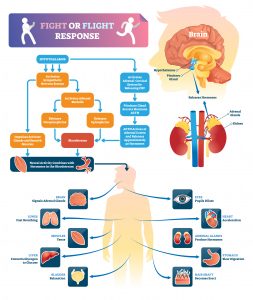
This is the fight or flight mechanism kicking in that much of our industrialized society lives in daily. News reports, traffic, the escalating cost of basic necessities can be perceived as danger/stress in our lives. The reaction is to either try to leave the situation or face it head on with aggression. If leaving the situation isn’t an option (which in many cases it may not be) We may turn to self-destructive (aggressive towards self) behaviors such as alcohol abuse, overeating, self-harm, or domestic abuse.
We may feel helpless in our situation without the tools to navigate these uncharted waters. Our goal is to calm the nervous system down so that we feel safe and secure and able to deal with whatever challenges that may come our way.
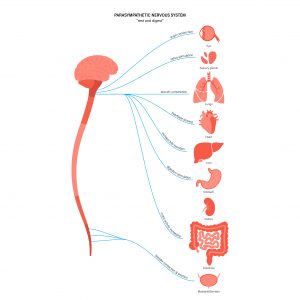
The action rest and digest state is where our bodies heal, our immune system is able to function at its best, blood pressure lowers, digestion is triggered and our decision making, and focus is appropriate.
4 steps to go from Reaction (fight or flight) to Action (Rest and digest)
- Have a positive mindset
A positive mindset is essentially exercise for the mind. It gets stronger and easier the more you do it. Start to focus on what you can do about a situation and not about what you can’t do. For instance, given the skyrocketing food prices there is much chatter on the internet about starting a garden, something not possible in an apartment setting. What could you do instead? Look for solutions. Tower gardens, and even starting sprouts for your salads are easy and inexpensive ways to start to take control of your food supply.
Essentially, instead of turning to destructive behaviors, start to focus on how to turn lemons into lemonade.
- Don’t get stuck with self-limiting beliefs
Self-limiting beliefs, such as not being good at crafts, exercise, gardening, school and coursework, etc. may not be true at all. We may have picked up on these beliefs as we grew up, or decided it was easier to believe we couldn’t do something rather than trying and finding out we can do it, given the proper training and tools. Even if you aren’t successful, the only failure isn’t trying something you really wanted to try.
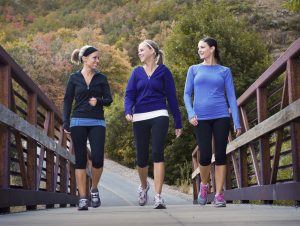
- Take control of your life
This goes along with # 1 and 2. Along with a positive mindset and trying out things you really wanted to do that you thought you couldn’t do is taking control of your life. What we put in our minds and bodies has profound effects on our wellbeing. Be aware of how much time you spend watching and listening to the news. Check in with your feelings. Take note- are you feeling empowered and able to tackle the challenges or does the news leave you feeling helpless and unable to cope? Food plays an important part of this equation. Along with adequate hydration (being slightly dehydrated can lead to feelings of depression) how you eat (not rushed, enjoyable atmosphere) and what you eat can have profound effects on your well-being. Be sure to eat adequate fruits and vegetables. Plan your meals ahead and if able, try to have foods and meals prepared ahead of time. This eliminates stress eating and the accompanying poor food choices.
Physical exercise plays an integral part of any self-care routine. A 15 minute walk every day has been proven to beat anxiety and depression in mildly depressed populations. While walking, focus on your surroundings. Take deep breaths and let go of negative thoughts.
Practice an attitude of gratitude. Write down 5 things you are grateful for every day, no matter how small. Do this for 30 days. It really is life changing!
Get good quality sleep, go to bed at a regular time (if possible) Have an evening routine. This signals your body it is time for bed and it will be easier to fall asleep. If you are having difficulty sleeping or falling asleep try turning off the wifi in your home and set your phone to airplane mode. Cellular signals and wifi can disrupt our sleep patterns. In addition, studies have found that blue light emitted from our computers and cellphones has negative effects on sleep and overall health
If you are on medication for any mental health condition, be sure to keep your appointments and have adequate supply of medicines on hand. This is one of the most important steps you can take in taking charge of your life.
- Reach out to community and loved ones for support
You are not alone in your feelings. Sometimes just talking out your concerns can turn a corner and bring solutions. One of the unintended consequences of the pandemic was social isolation. We are social beings with a need to connect with each other.
If unable to find positive, supportive community or loved ones you feel comfortable talking to seek online mental health counselling.
The following are a few websites and phone numbers that can help you navigate this terrain.
National Alliance for Mental Illness (NAMI)
Suicide Prevention Hotline 800-273-8255
National Domestic Violence Hotline
After antibiotics, Restoring Gut Health
Antibiotics are literally lifesaving. In the most dire of circumstances they can bring someone back from the brink of death. They are powerful medicines. Our lives have greatly benefitted from the use of antibiotics, whether we have used them or not. They have saved millions of lives and the lives of our animals. At Jase medical we take antibiotic stewardship very seriously and advise only using them under the supervision of your healthcare provider. There is much concern over the use of antibiotics and its ability to wipe out the delicate flora of our gastrointestinal system. This concern is founded.
Antibiotics anti- against, biotic- life- against life.
Once someone starts a course of antibiotics the entire course must be completed to kill the invading organism. This comes at a cost to our bodies, however. While the antibiotic kills off the harmful organism it also kills off beneficial bacteria. A study titled “ Short-Term Effect of Antibiotics on Human Gut Microbiota” revealed that after taking certain antibiotics there was up to a tenfold decrease in gut microbiota. Some studies show gut bacteria can return to normal within 6 months. Other studies conclude it can take years. There is much debate over this topic. The type of antibiotic, age, sex, and overall health contribute to gut health and bacterial diversity returning to normal.
This can result in an opportunistic bacteria or yeast to overtake and invade the body. Some people are prone to yeast infections during the course of therapy. Sometimes prescription antifungals are used, in other instances a diet rich in probiotic rich yogurt, over the counter creams and mouthwashes can help.
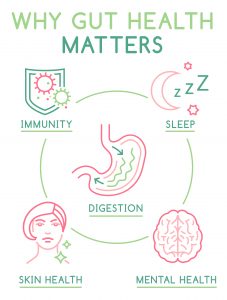
Our gut houses our immune system
Our immune system is housed in our intestines in tissue known as GALT- gut associated lymphatic tissue. Over 70 percent of our immune system is housed in this tissue, and when taking oral antibiotics, it puts a strain on this part of our immune system. Some of the cells the GALT produces prevent pathogens from adhering and taking up residence in our intestines. The GALT also includes Peyers patches. These patches, which are very similar to spleen cells, line the intestine and house white blood cells. They monitor and kill pathogenic bacteria and viruses when healthy and functioning. They also play an important role in in anti-inflammatory responses. Use of antibiotics puts a strain on this important and not too often talked about system.
In order to restore health to our entire gastrointestinal system functional medicine has come up with the acronym known as the 4 Rs to gut health- remove the offending substance, replace with beneficial foods and bacteria, reinoculate and repair the damage. There is no real definite way to repair the damage, however a diverse gut microbiome helps fight off a variety of pathogenic bacteria.
These steps should be taken during antibiotic therapy and should be a part of a health promoting lifestyle if not already in place.
Remove offending substance
This step can include removing foods that can cause opportunistic bacteria to grow, such as sugar and processed foods, sodas, and high sugar juices. In addition, avoid alcohol, cigarettes, and stress. These suppress the immune system and can make healing the gut very difficult.
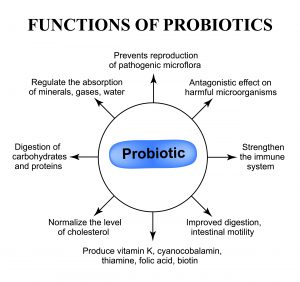
Replace with probiotic and prebiotic rich foods and probiotics
Probiotic rich foods
Probiotic rich foods help inoculate the gut with beneficial bacteria and promote include yogurt with active cultures, kefir, fermented foods such as sauerkraut, kimchi, tempeh, other fermented vegetables and kombucha. You don’t need a lot of these foods to benefit. A tablespoon of sauerkraut provides a group of bacteria called lactic acid bacteria which evidence shows helps fight cancer, contributes to cardiovascular health and even metabolism. Kefir is known for its powerful anti-inflammatory effects and fights viral infections. As a side note, kefir has been speculated to reduce or prevent cytokine storm associated with Covid 19.
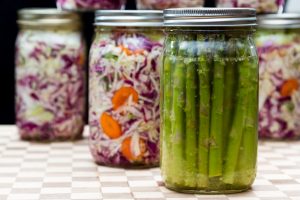

Prebiotic rich foods
A substance called butyrate is a short-chain fatty acid produced by your gut microbes when they break down dietary fiber. Butyrate has numerous health benefits. butyrate is produced when your gut microbes transform the dietary fiber you eat into these beneficial compounds. These compounds help feed the beneficial bacteria in your gut lining; without butyrate your beneficial bacteria wouldn’t survive. Butyrate is made from prebiotic rich foods that your intestine ferments and digests food. Foods high in fiber promote butyrate production such as whole grains, legumes, berries, fresh fruits, and vegetables. Inulin, a prebiotic fiber found in Jerusalem artichokes, chicory root, unripe(green) bananas, and asparagus has been found to positively modulate bacterial diversity during antibiotic therapy
A probiotic called Saccharomyces Boulardii (Trade name Florastor) has been shown to help prevent antibiotic related diarrhea and fight candida infections while on antibiotic therapy. It is a beneficial yeast and not a bacteria, so it isn’t affected by antibiotics. Saccharomyces Boulardii should be taken during antibiotic therapy and for a month after or as your healthcare provider recommends.
Reinoculate
Along with the above recommendations a good probiotic supplement may be necessary to restore gut health. Due to supply chain issues the probiotic I would recommend is no longer available, however here is a link-perhaps you may be able to source a similar product- check with your healthcare provider which probiotic they recommend.
Repair
To repair damage caused by illness and antibiotic therapy Supplementation with L-glutamine, vitamin C and zinc may be necessary. A good quality, balanced multivitamin is also a good idea.
Continue with above recommendations and make this change a permanent lifestyle.
In conclusion
As we enter this time of supply chain disruption and uncertainty the one asset, we and our loved ones have is our health. Without that nothing else matters.
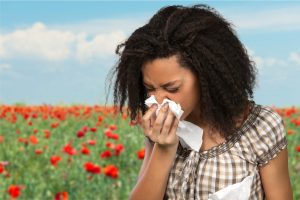
As the winter draws to an end and spring emerges, along with the warmer temperatures comes with it the increase in pollen and mold. This time of year can be a challenging, and miserable time of year for those suffering with seasonal allergies.
The CDC estimates that 60 million people in the United States suffer from seasonal allergies. Some people are more prone to allergies than others, such as asthmatics and those suffering from other respiratory diseases.
Is it a cold or allergy?
Colds and allergies share many of the same symptoms. How to tell if you are coming down with a cold or allergies?
According to WebMD:
A cold is an infection caused by a virus. Allergies are your immune system’s reaction to a substance like pollen or pet dander. Because the two conditions cause similar symptoms, like sniffles and stuffiness, many people get them mixed up. Knowing which is which can help you get the right treatment, and that will help you feel better faster.
It’s Probably Allergies If:
Your mucus is clear or watery. And it will stay clear, instead of becoming thick or discolored like it can with a cold, says Michael Benninger, MD, an ear, nose, and throat specialist at the Cleveland Clinic.
Your eyes are itchy or watery. It’s rare to have itchy eyes when you have a cold.
Your symptoms stay the same. “Allergies may feel extra intense for the first day or 2, but you’ll have the same symptoms day after day,” Benninger says.
You’ve had the sniffles for more than a week. A cold usually clears up in 7 to 10 days, but allergies can last several weeks or longer.
Your symptoms show up only in certain situations. Find yourself sneezing every spring or fall? Those are common times for allergies. ( Colds and the flu usually show up in the late fall and winter.) Another allergy tip-off: Being in a specific place makes you feel miserable — for example, in a house with a cat.
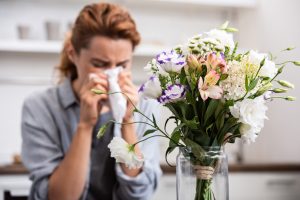
How to deal with allergies:
1) Remove the offending substance- are there houseplants in bloom that are causing your symptoms? Strong odors from room fresheners or perfumes can cause allergic reactions. Any animals that you may be allergic to? You may need to consider avoiding them if able.
2) Vacuum floors, walls and windowsills and wipe down all surfaces with a few drops of tea tree oil and water. The tea tree oil helps kill mold and keeps it from coming back.
3) Run a portable hepa filter in your room, especially in the room you sleep in. Leave it on for at least 24 hours with the door closed to begin with. This will clear out any allergens, dust and mold that may be in the air. After the initial 24 hours has passed run the filter during the day and try shutting off at night if the sound bothers you.
4) Eat raw, local honey. This helps prime your immune system to recognize your local pollen as a normal part of the environment, not something to react to.
5) Try cutting out dairy for a week. Studies have shown that eating dairy can exacerbate inflammatory responses and make allergies worse. Dairy also causes mucus buildup and can make symptoms worse.
6) Use a neti pot to rinse out sinus passages. This will remove the pollen and help alleviate allergies. Be sure to use sterile water when using the neti pot.
7) Try taking probiotics, specifically Kyo-Dophilus, a probiotic combination of lactobacilli and bifidobacteria in the form of a capsule sold in stores. This probiotic was shown to reduce allergic symptoms in a study conducted by University of Florida food, science and human nutrition department. It may not cure your allergies, however it is widely known that healthy gut bacteria regulate and strengthen the immune system and fight inflammatory responses.
8) Drink plenty of good quality water. This helps flush out irritants invading your sinus membranes.
9) Throw your pillows in the dryer on high every week for 15 minutes to kill dust mites. Dust mites can cause allergies and love the warm dark and damp environment your pillows provide. While you are at it, wash bedding frequently, not just bedsheets.
10) Make sure your air conditioner and heater filters, vents and crawlspaces are cleaned and changed periodically. You could inadvertently be blowing in irritants from the filters when you use these appliances.
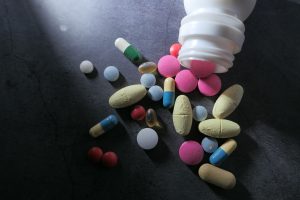
Allergy medications, prescription and over the counter
If you are on any allergy or asthma prescription medication, be sure to have plenty on hand. Make sure inhalers, epi-pens and medications aren’t expired and if they are getting close to expiration obtain a fresh supply.
Over the counter allergy medications– many used to be prescription- can have side effects. Benadryl, for example has been shown to cause driving impairment on par with alcohol ingestion. In fact, in California you can be arrested if under the influence of Benadryl or other medications that impair your driving. Allergy medicines can interact with other medications. Check with your primary care provider before taking any allergy medicines.
A good website for information on drug interactions and what to avoid is is the FDA site: Some Medicines and Driving Don’t Mix.

Among one of the most serious complications of a medical supply shortage is shortage of insulin for insulin dependent diabetics. The threat is getting very real, given current events.
The media has been very quiet about medical supply chains. Given the instability of the entire world, sanctions, ports closed, Chinas largest city in lockdown, the time to prepare is YESTERDAY. The next best time is NOW.
- Only three companies—Novo Nordisk, Sanofi, and Eli Lilly—provide insulin to the United States market.
- The American Diabetes Association (ADA) estimated that more than 30 million Americans, or more than 9 percent of the population live with diabetes
According to the ADA:” What is insulin dependent diabetes?
Diabetes is a problem with your body that causes blood sugar (also called blood glucose) levels to rise higher than normal. This is also called hyperglycemia.
When you eat, your body breaks food down into sugar and sends it into the blood. Insulin then helps move the sugar from the blood into your cells. When sugar enters your cells, it is either used as fuel for energy right away or stored for later use. In a person with diabetes, there is a problem with insulin. But, not everyone with diabetes has the same problem.
In type 1 diabetes, your immune system mistakenly treats the beta cells in your pancreas that make insulin as foreign invaders and destroys them. This can happen over a few weeks, months, or years.
When enough beta cells are gone, your pancreas stops making insulin or makes so little insulin that you need to take insulin to live. Type 1 diabetes develops most often in young people but can also appear in adults.”
Covid infection will lead to supply strain due to increase in insulin dependent diabetes diagnosis
Researchers found that people who had COVID-19 were about 40% more likely to develop diabetes within a year after recovering, compared to participants in a control group.
SARS-CoV-2 INFECTION LEADING TO TYPE 1 DIABETES
According to the NIH SARS-CoV-2 site titled “The diabetes virus” SARS-CoV-2 can interact with several proteins on the surface of cells in the body, allowing the virus to gain access to the cell. But those proteins are present in different levels for different cells. Researchers discovered that beta cells — the cells that make insulin in the pancreas — have a higher level of one of those proteins, neuropilin, than other pancreatic cells. In one study, researchers examined lab-grown beta cells infected with COVID-19 and found that they made less insulin when infected with the virus. Some of the cells died outright.
In the other study, researchers found that infection effectively reprogrammed some of those lab-grown cells. Instead of producing insulin, which breaks down blood sugar, they started producing glucagon, which increases blood sugar.
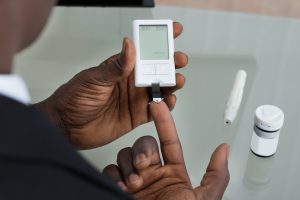
The following isn’t medical advice, consult your healthcare provider for your medical needs
What to do if you are unable to get insulin
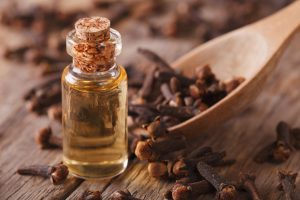
- Make sure you have plenty of supplies- lancets, syringes etc, Buy extra of everything and then some
- Follow a strict diet. Don’t deviate. Keep carbs to a minimum
- Be sure to have electrolyte solution or powder available in case of high blood sugar readings. Electrolytes are lost during these episodes. Keep hydrated!
- Keep stress level at a minimum, pray, meditate, read, do art, garden. Stress raises cortisol levels, which in turn raise blood sugar levels
- If there is truly no insulin you may want to consider rationing your doses. Your ideal blood sugar reading may be higher than ideal by doing this. The danger of this is ketoacidosis. (see below for signs and symptoms of ketoacidosis) This will be a judgement call on your part
- Have extra supplies- lancets, testing strips, syringes,
- Make sure you have enough batteries for your glucometer
- Have a backup glucometer along with supplies in case of malfunction
- Let everyone in your group know you are insulin dependent and educate all members on what normal glucose ranges are for you, signs, and symptoms of high and low blood sugar and what to do if your blood sugars are too high (or too low)
- Instruct all able-bodied members on use of your glucometer
Diabetic Ketoacidosis, a real threat during an insulin shortage
Diabetic ketoacidosis (DKA) is life-threatening—learn the warning signs to be prepared for any situation.
DKA is no joke, it’s a serious condition that can lead to diabetic coma or even death. DKA is caused by an overload of ketones present in your blood.
When your cells don’t get the glucose they need for energy, your body begins to burn fat for energy, which produces ketones. Ketones are chemicals that the body creates when it breaks down fat to use for energy. The body does this when it doesn’t have enough insulin to use glucose, the body’s normal source of energy. When ketones build up in the blood, they make it more acidic. They are a warning sign that your diabetes is out of control or that you are getting sick.
DKA usually develops slowly. But when vomiting occurs, this life-threatening condition can develop in a few hours. Early symptoms include the following:
- Thirst or a very dry mouth
- Frequent urination
- High blood glucose (blood sugar) levels
- High levels of ketones in the urine
Then, other symptoms appear:
- Constantly feeling tired
- Dry or flushed skin
- Nausea, vomiting, or abdominal pain. Vomiting can be caused by many illnesses, not just ketoacidosis. If vomiting continues for more than two hours, contact your health care provider.
- Difficulty breathing
- Fruity odor on breath
- A hard time paying attention, or confusion
Warning! DKA is dangerous and serious. If you have any of the above symptoms, contact your health care provider IMMEDIATELY, or go to the nearest emergency room of your local hospital.
Symptoms of low blood sugar
(Just as life threatening but less common if lack of insulin)
If blood sugar levels become too low, signs and symptoms can include:
- An irregular or fast heartbeat
- Fatigue
- Pale skin
- Shakiness
- Anxiety
- Sweating
- Hunger
- Irritability
- Tingling or numbness of the lips, tongue or cheek
As hypoglycemia worsens, signs and symptoms can include:
- Confusion, abnormal behavior or both, such as the inability to complete routine tasks
- Visual disturbances, such as blurred vision
- Seizures
- Loss of consciousness
When to see a doctor
Seek a doctor’s help immediately if:
- You have what might be hypoglycemia symptoms and you don’t have diabetes
- You have diabetes and hypoglycemia isn’t responding to treatment, such as drinking juice or regular soft drinks, eating candy, or taking glucose tablets
Seek emergency help for someone with diabetes or a history of hypoglycemia who has symptoms of severe hypoglycemia or loses consciousness.
Part 5 of 5
9 months later….
You are sitting at your desk, sipping your second cup of coffee. “Feels good to be back’” you think to yourself. It’s a slow day at work. Slower than usual. Since the bioterror event your hours have been cut. You have been back to work for almost 8 months, and now come into work only 3 days a week. Overall, however, you are very grateful you still have a job. Working IT security has proven to be a recession resistant career.
Your mind wanders back to the first days and weeks of the Tularemia bioterrorism event. The chaos that followed the announcement of the event came swiftly and violently. It was amazing the way civilization deteriorated and fell completely apart. Even in your own neighborhood car break ins and a few attempted burglaries occurred. Since most people were required to say home, the would-be burglars were met with force. Emergency personnel and law enforcement were almost nonexistent.

Order was slowly restored when the sleeper cell of 30 individuals that had infiltrated the Dugway Proving Ground biolab (located in Utah) and had covertly set up shop manufacturing enough Tularemia for their event. You suspect the general public will never know what really happened. However, the event was isolated to commercial aircraft air vents and the samples of organic powder sent in the mail.

During those few stressful weeks and months that followed, many shipping containers filled with medical supplies and toiletries were destroyed. The high temperature (160F) needed to kill the virus ruined many medications. Irradiation was an option, however given the fact it is one of the most pathogenic (disease spreading) bacteria known to man, it could escape UV light exposure. Documents found in the sleeper cell revealed where the bio attack had been scheduled to take place.
Unfortunately, the delay in discovering the papers led to unnecessary destroying of medication, medical supplies fresh produce and many other temperature sensitive items. This left a huge void in the supply chain. Many people were left without their blood pressure medications, antidepressants, diabetic medications, and hospitals were struggling with the dwindling supply of medications and supplies to keep their emergency rooms open. The attack had initially been written off as an early flu when people started pouring into the clinics and hospitals. The symptoms were very similar to the old-fashioned flu. However, as more and more people started succumbing to their illness, a doctor decided to test for bioterror agents. It seemed unlikely at the time, but the higher than usual mortality rate had her concerned.
During this time, while the nation was under stay-at-home orders, you started feeling very uneasy about how vulnerable your household was. You had been able to avoid going to the doctor a few times to get a prescription for antibiotics using the Jase case, but did the case have other uses? Between your injured thumb and your daughter’s bout with Giardia, the antibiotic kit had proven itself invaluable. During that stay-at-home time frame, you reviewed the different medications in the case. One of the antibiotics that caught your attention was the Amoxicillin-Clavulanate. The stated uses were for bite wounds (human or animal), Pneumonia (in combination with Azithromycin or Doxycycline) and sinusitis. You recalled a few years back your younger son had been bitten by your cat and his hand had become infected. You took him down to the local clinic and he was prescribed an antibiotic. “I’m pretty sure that the prescription was for that antibiotic, it looks familiar” you recall.
During the last 9 months you became active in your HOA, attending meetings and working with the members to change rules. One was the prohibition of planter boxes for food production in place of front yard lawns. Another was to allow up to 6 chickens per household in the back yard if noise and sanitary conditions met. Your paramedic neighbor started holding first aid classes and emergency preparedness meetings. Two streets down was a retired home economics teacher. She offered to host small groups to learn to can and sew. Her husband is an amateur radio operator and obtained permission from the HOA to put up a long-range antenna in their backyard, as long as the antenna didn’t interfere with power lines. So much change. You were getting to know your neighbors, his children had newfound friends. Your wife loved the interaction with the neighbors. A neighborhood watch was instituted which was a relief after the car break-ins and attempted burglaries.
Your daydreaming was cut short as you realized it was time to go home.
Sliding into your car seat, you turn the radio on. The evening news was playing. Your weather forecast sounded good for getting your planter boxes planted and watered tonight. Gas prices were going up due to rumors of war. You heard mention of a new strain of bird flu and the culling of thousands of animals in your nearby state. You take mental note of this since you are due to pick up your 6 baby chicks this weekend. Supply chain disruption still ongoing. Crop failures and sanctions on countries providing fertilizers could cause food prices to spike.
You turn the radio to classical music, take a deep breath and realize the bioterror attack motivated your community to become more self-reliant. But you aren’t naïve. You know you still have a long way to go.
Postscript
As I was researching the topic of bioterrorism for this series, I discovered how very little I knew and how very real the threat is. Chemical and bioterror attacks are more a reality than I previously thought or cared to admit. I knew about our own labs, such as Fort Detrick, but didn’t know the extent of our contracts with other countries and even on our own soil that these labs covered. Please do your own research. And please get prepared.
Part 4 of 5
As the week wore on you see on the tv that people are panicking. Looting stores, setting cars on fire, and general hysteria has set in. “Why do people do these things?” you think to yourself.
The refrigerator is almost empty. The stay-at-home orders are still in effect. Only emergency travel is allowed. The National guard has been deployed and had stopped by your home earlier in the day. They were going door to door running wellness checks. They had dropped off food and some bottled water. It wasn’t enough for any length of time, but you take it and thank them. They also inquire if anyone in the home has medications, they are running short of, especially insulin. No one in your house is short on medications, all prescriptions had been fille da few days before your vacation. You inquire about the insulin and why they asked about it specifically. There is a shortage of insulin and other medical shipments due to the bioterror scare. Every container has to be decontaminated. The Strategic National Stockpile has been accessed and is being distributed on an as-needed basis. You ask how long this stay-at-home order will be in effect. “No idea” is the answer.
News on the street was that no one had claimed responsibility for the attacks. There was evidence that commercial jets duct work had been contaminated with airborne Tularemia, the type found in the organic powders that had been mailed. The investigation and incidence of Tularemia was growing, with no real pattern evolving according to news reports. The CDC made a statement that the most effective and realistic approach was to provide antibiotics to the entire population. However, since there was essentially no movement of cargo, especially cargo containing medical supplies and medicine, this was proving very difficult. There simply wasn’t enough doxycycline or ciprofloxacin for everyone.
By Thursday complete breakdown of civilization as you have always known it has taken effect. Grocery stores were open; however, no one was allowed in the stores. You could phone in or place an online order and park your car and wait for the clerk to bring the groceries to your car. However, even going to the store was unsafe. Grocery stores were emptied from mass mobs of people rushing the doors. Broken windows and glass littered the parking lots. Specially assigned National guard were helping with maintaining mob control and deliveries to homes. The fact was there were too few National Guard for the immense task.
Garbage service stopped. Trash was overflowing the garbage cans. Hospitals had become overrun with patients who felt they may have been exposed to Tularemia, the hysterical and anxious, heart attack victims, crash victims driving erratically (even though there was a stay-at-home order in effect) due to the stress.
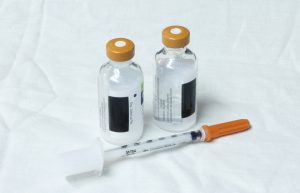
Your neighbor has called, asking if anyone has any insulin to spare. Their mother, an insulin dependent diabetic is almost out of her insulin. No one in your family uses insulin so you aren’t able to help.
You start to worry about people who may be in the same situation as your neighbor. What will they do if they aren’t able to get their lifesaving medications?
That afternoon you sit down with your wife and children and have a talk. You explain the situation, that because of your vacation and travel plans you had purchased plenty of food to last for a few weeks. You also bring out one of the Jase cases and pull out the booklet and show your children the two antibiotics recommended for Tularemia are in the Jase case if needed. You also remind your children that feelings of anxiety are normal during these stressful times and that each morning and evening you all meet at the kitchen table to talk over any concerns. You assign each child a day to pick an activity to keep your family focused and productive. The backyard has needed weeding and the fruit trees need watering. The fence needs repair. Extra paint in the garage that was used to paint the living room can be used to touch up scrapes scuff marks from furniture. Your wife and daughter (who is feeling much better) find exercise videos on You Tube to help relieve stress.
On Saturday you invite your paramedic neighbor over. Since Tularemia isn’t spread from person to person you feel safe having him over. You discuss the phone call you received from your mutual neighbor in regard to the request for insulin. He says he was able to procure enough insulin to last your mutual neighbor for a few weeks.
“This is quite the wake-up call”’ you say to your paramedic neighbor, “If we hadn’t had the Jase cases you recommended, I would be concerned and even feel desperate.”
You pull out your Jase case and review the 5 antibiotics in the case. “According to the booklet the Azithromycin can be used for pneumonia, urinary tract infection and Travelers diarrhea. You review the other medicines in the case with your paramedic neighbor. “These antibiotics cover a wide range of illnesses, from infected animal bites to other bioterror exposures (Anthrax and Plague) and even Tetanus. We have already seen the benefit of having these antibiotics in our family.”
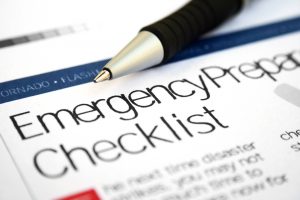
You realize the fact you had enough food (because of stocking up for vacation) and having the Jase cases for each family member helped keep you and your family out of harms way from the hysterical and violent mobs in town.
This is a wake-up call. Once this crisis is over you are determined to be more prepared. But where do you start?

















